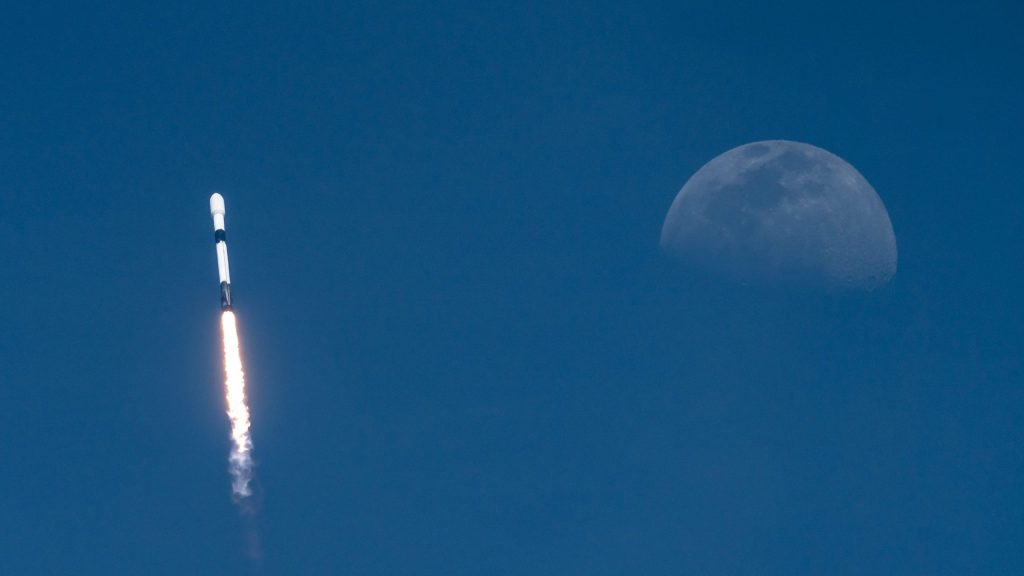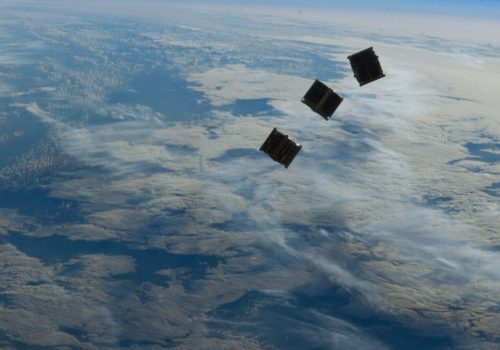Navigators long plotted their course by stars. For the US Coast Guard—the nation’s maritime first responder, but which is also bound by international obligations—it’s small satellites that could shape its future direction.
Maritime search-and-rescue (SAR) operations start in space, with satellites detecting signals of distress. But this military branch relies on aging space-based infrastructure with spotty global coverage that limits its ability to conduct swift and effective SAR, particularly in the vast Arctic Ocean. To provide adequate coverage in an increasingly trafficked region, the Coast Guard must invest in small satellite technology.
The urgency is only growing. Maritime traffic in the Arctic has increased as climate change continues to warm this area at a disproportionately high rate. Since 1979, there has been a substantial decline in the amount of sea ice in the Arctic; now, some portions are almost ice-free in September and ships regularly transit during the summer. It is a valuable shipping route: For example, it is more efficient to go from the coast of China to Europe through the Northern Sea Route (of which Russia considers itself the sole regulator) than the traditional route through the Strait of Malacca and the Suez Canal. Meanwhile, the Northwest Passage, which hugs the Arctic coast of North America, has seen a growth in tourism. Since the inaugural cruise ship in 2016 carried 1,700 passengers, cruise lines are reportedly preparing to meet what’s expected to be increased demand for Arctic tourism.
With this traffic growth comes a higher risk of ships in distress—thus necessitating a larger Coast Guard presence to render humanitarian aid to commercial and passenger vessels, some of which carry Americans.
The case for CubeSats
The Arctic presents the Coast Guard with multiple obstacles to providing effective SAR operations. US territorial waters in the Arctic Ocean, plus those associated with its Exclusive Economic Zone, make up around one million square miles. This is a vast amount of geography for the Coast Guard to cover.
Since 1982, it has relied on a satellite-aided international search-and-rescue system known as COPAS-SARSAT, which is sponsored by Canada, France, Russia, and the United States and provides global coverage for distress beacons. The system has saved more than 44,000 lives but has experienced significant time delays in receiving and triangulating distress beacons. The Coast Guard is developing a medium Earth orbit system (MEOSAR) to replace COPAS-SARSAT, but it will not be fully operational until the mid-to-late 2020s.
To bridge that gap and to test the effectiveness of small satellites, the Coast Guard (which is under the Department of Homeland Security) launched its Polar Scout program. Its mission was to enhance telecommunications coverage in the Arctic to support SAR and maintain effective domain awareness by using cube satellites (CubeSats). These objects are about the size of a shoebox, compared with the minivan-sized COPAS-SARSAT system.
To support the Polar Scout program, the DHS, in partnership with private firm SpaceX, launched two CubeSats, Yukon and Kodiak, into low-Earth orbit in December 2018. They were programmed to detect a distress signal, determine its location, and send the information to the nearest rescue hub. While the Coast Guard was aiming for a three-year lifespan, the Yukon stopped transmitting after just a few weeks and the Kodiak stopped transmitting in April 2019.
But this effort was not a failure. The Kodiak was still able to successfully detect distress signals for several months for a fraction of the cost compared to the COPAS-SARSAT or the forthcoming MEOSAR system. Small satellites are cheaper and easier to build with the commoditization of small-satellite components; the cost of launching satellites has also decreased due to reusable rockets and ride-sharing programs. The Yukon and Kodiak CubeSats were both launched in a SpaceX Falcon 9 rocket, which was being reused for the third time.
Companies such as SpaceX and Planet, an Earth imaging company, continue to improve the transmission reliability and processing power of small satellites. These companies have a quick turnaround timeframe from development to launch to ensure that the latest technology is in place. Therefore, the Coast Guard should see the Polar Scout program as a success story and seek to replicate it on a wider scale and expand its partnerships with the space industry.
Boosting the budget for space capabilities
But to support its SAR operations, the service needs to appropriately house and fund its space-based assets. First, it needs to designate an office dedicated to the proper maintenance, research, acquisition, and funding of its space programs. It should establish a space-assets program office under the purview of the assistant commandant for engineering and logistics (who is the chief engineer of the Coast Guard), rather than keep it in the Office of Aeronautical Engineering, which focuses primarily on aircraft—not spacecraft.
Second, the Coast Guard must increase its budget for space assets and adapt its acquisition process. For the first time, the Coast Guard’s 2023 budget request to Congress included $775,000 for research and development for “Space-based Technology.” But this funding is relatively minuscule compared to other missions, such as cyber operations. The Coast Guard essentially has two options: Buy a few high-quality satellites or buy many adequate satellites. To provide continuous coverage of the Arctic, it should choose the latter and invest in creating a small constellation of these advanced, shoebox-sized satellites.
Such a set-up would be more reliable, as it ensures that even if a couple units go offline there will still be continued coverage. This constellation, like the stars to ancient mariners, should be central in setting the Coast Guard’s course.
Madison Littlepage is a spring 2022 Young Global Professional within the Scowcroft Center for Strategy and Security’s Forward Defense practice. She is a graduate student in security policy studies at The George Washington University.
Further reading
Thu, May 5, 2022
Small satellites: The implications for national security
Report By Nicholas Eftimiades
Forward Defense nonresident senior fellow Nicholas Eftimiades considers how the US government can better leverage commercial satellites to enhance space security.
Wed, May 25, 2022
Eye to eye in AI: Developing artificial intelligence for national security and defense
Report By Tate Nurkin, Margarita Konaev
As artificial intelligence transforms national security and defense, it is imperative for the Department of Defense, Congress, and the private sector to closely collaborate in order to advance major AI development priorities. However, key barriers remain. As China and Russia develop their own capabilities, the stakes of the military AI competition are high, and time is short.
Fri, May 13, 2022
What does the future of autonomous warfare look like? Four critical questions, answered.
Automating the fight By
Experts from the Scowcroft Center for Strategy and Security’s Forward Defense practice break down how these autonomous systems will shape the future of battle.
Image: A SpaceX Falcon 9 rocket launches the NileSat-301 commercial communications satellite from Cape Canaveral Space Force Station on Wednesday, June 8, 2022. Photo by Emre Kelly/FLORIDA TODAY/ USA TODAY NETWORK/REUTERS



